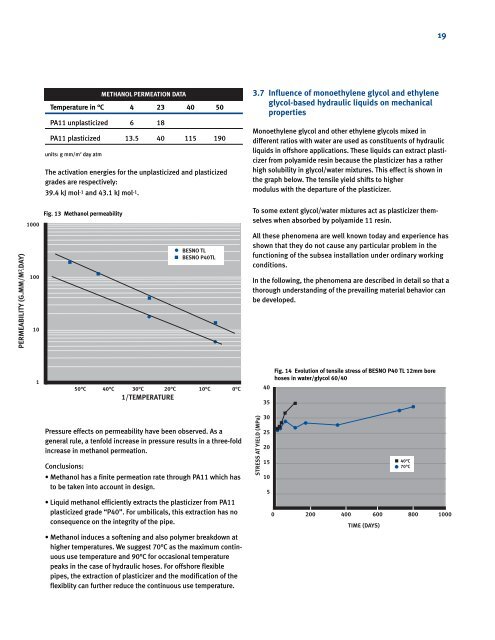RILSAN® Polyamide 11 in Oil & Gas Off - HCL Fasteners Ltd
RILSAN® Polyamide 11 in Oil & Gas Off - HCL Fasteners Ltd
RILSAN® Polyamide 11 in Oil & Gas Off - HCL Fasteners Ltd
You also want an ePaper? Increase the reach of your titles
YUMPU automatically turns print PDFs into web optimized ePapers that Google loves.
PERMEABILITY (G.MM/M 2.DAY)<br />
1000<br />
100<br />
10<br />
1<br />
METHANOL PERMEATION DATA<br />
Temperature <strong>in</strong> °C 4 23 40 50<br />
PA<strong>11</strong> unplasticized 6 18<br />
PA<strong>11</strong> plasticized 13.5 40 <strong>11</strong>5 190<br />
units: g mm/m 2 day atm<br />
The activation energies for the unplasticized and plasticized<br />
grades are respectively:<br />
39.4 kJ mol-1 and 43.1 kJ mol-1. Fig. 13 Methanol permeability<br />
■<br />
■<br />
• BESNO TL<br />
■ BESNO P40TL<br />
50°C 40°C 30°C 20°C 10°C 0°C<br />
1/TEMPERATURE<br />
Pressure effects on permeability have been observed. As a<br />
general rule, a tenfold <strong>in</strong>crease <strong>in</strong> pressure results <strong>in</strong> a three-fold<br />
<strong>in</strong>crease <strong>in</strong> methanol permeation.<br />
Conclusions:<br />
• Methanol has a f<strong>in</strong>ite permeation rate through PA<strong>11</strong> which has<br />
to be taken <strong>in</strong>to account <strong>in</strong> design.<br />
•Liquid methanol efficiently extracts the plasticizer from PA<strong>11</strong><br />
plasticized grade “P40”. For umbilicals, this extraction has no<br />
consequence on the <strong>in</strong>tegrity of the pipe.<br />
• Methanol <strong>in</strong>duces a soften<strong>in</strong>g and also polymer breakdown at<br />
higher temperatures. We suggest 70°C as the maximum cont<strong>in</strong>uous<br />
use temperature and 90°C for occasional temperature<br />
peaks <strong>in</strong> the case of hydraulic hoses. For offshore flexible<br />
pipes, the extraction of plasticizer and the modification of the<br />
flexiblity can further reduce the cont<strong>in</strong>uous use temperature.<br />
■<br />
•<br />
■<br />
•<br />
3.7 Influence of monoethylene glycol and ethylene<br />
glycol-based hydraulic liquids on mechanical<br />
properties<br />
Monoethylene glycol and other ethylene glycols mixed <strong>in</strong><br />
different ratios with water are used as constituents of hydraulic<br />
liquids <strong>in</strong> offshore applications. These liquids can extract plasticizer<br />
from polyamide res<strong>in</strong> because the plasticizer has a rather<br />
high solubility <strong>in</strong> glycol/water mixtures. This effect is shown <strong>in</strong><br />
the graph below. The tensile yield shifts to higher<br />
modulus with the departure of the plasticizer.<br />
To some extent glycol/water mixtures act as plasticizer themselves<br />
when absorbed by polyamide <strong>11</strong> res<strong>in</strong>.<br />
All these phenomena are well known today and experience has<br />
shown that they do not cause any particular problem <strong>in</strong> the<br />
function<strong>in</strong>g of the subsea <strong>in</strong>stallation under ord<strong>in</strong>ary work<strong>in</strong>g<br />
conditions.<br />
In the follow<strong>in</strong>g, the phenomena are described <strong>in</strong> detail so that a<br />
thorough understand<strong>in</strong>g of the prevail<strong>in</strong>g material behavior can<br />
be developed.<br />
STRESS AT YIELD (MPa)<br />
40<br />
35<br />
30<br />
25<br />
20<br />
15<br />
10<br />
5<br />
Fig. 14 Evolution of tensile stress of BESNO P40 TL 12mm bore<br />
hoses <strong>in</strong> water/glycol 60/40<br />
0 200 400 600 800 1000<br />
TIME (DAYS)<br />
40°C<br />
70°C<br />
19


